- 1 Social Media for Business (B2B and B2C marketing)
- 2 Using Facebook for business
- 3 How effective is Instagram?
- 4 Should businesses be using Twitter?
- 5 Using YouTube for business
- 6 How beneficial can LinkedIn be for businesses?
- 7 Other social media channels explored
- 8 Social media marketing – is essential in any digital strategy
- 9 Contact Opace today
The social media industry is growing exponentially, and there are no signs of it slowing down any time soon. For businesses looking to expand, having an active social media presence is the way forward. In this article, we have summarised how different social media channels can be good for business, so if you want to find out more, please read below.
Using Facebook for business
A social media channel with access to over two billion people, Facebook is undeniably an effective marketing tool. This platform allows users to connect with one another through posts, comments, games and a live chat feature. Each user has their own personal wall and a news feed where they can see posts other users have commented on or posted themselves.
Facebook is known to be great for B2C, but can be effective as B2B too
There are many benefits of using Facebook for business, and perhaps its biggest benefit is the targeted advertising feature. Businesses can use this to target their adverts to a specific demographic in order to generate traffic and sales.
The targeting options a business can choose from are extensive, including age, sex, employment status, education, location and interests. All these targeting options, alongside many others, can be filtered to allow businesses to tailor an advert to a very specific demographic. Targeted advertising does come at a cost, however, and its price increases based on how specific your targeting options are; this may, unfortunately, limit those businesses who are able to utilise this feature. However, overall Facebook is a low-cost marketing tool for business, with an advert costing approximately $0.25 per 1,000 impressions; compare this with LinkedIn, where the CPC of adverts ranges from $2 to $5 dollars.
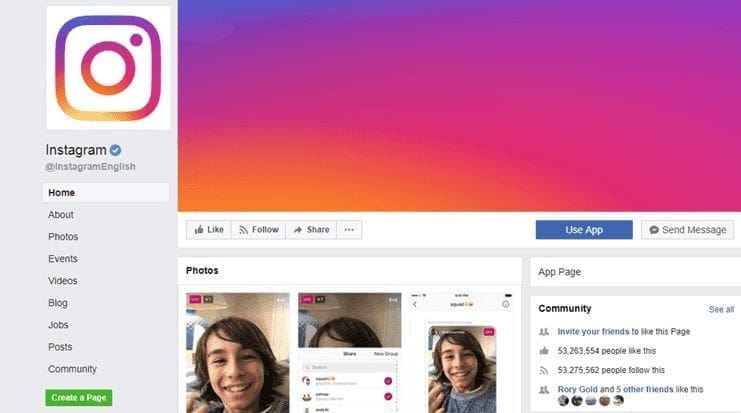
An example of a Facebook page from Instagram – what can you create?
One such company that has utilised targeted advertising extremely well on this social media platform is Red Bull. Red Bull’s Facebook content is based primarily around an active lifestyle and sporting events; something which is both in tone with the image the company is trying to create, and appealing to their demographic of people leading an active lifestyle.
Customers want a personal experience and content that they can fully engage with. For businesses on Facebook, this has never been easier. A user can easily share content onto their page, add a company description and link to an external website, making the Facebook page vibrant and enticing through the use of a cover photo or profile picture.
This allows businesses to create a user-friendly Facebook page, where they can post pictures, videos or other pieces of information about related products or services, helping to build trust with their followers.
Facebook is an extremely easy to use social media channel, and because of its user-friendly nature and attractive interface, this channel is often more popular for B2C companies rather than B2B companies.
At Opace, we compared traffic generation to the external websites of a number of our clients. Unsurprisingly, our B2C clients were receiving a greater proportion of their traffic from Facebook than our B2B clients; one found that a staggering 86% of its traffic came from this social media channel alone. However, many of our B2B clients were also experiencing success using this channel; two of our clients found that 35% and 43% of their traffic came from this site, respectively.
Analysing the ROI of a social media channel for business is difficult, as it can be measured in so many different ways, including revenue, traffic and leads, for example. However, the ROI potential of Facebook is huge, owing to the various features that allow businesses to both connect and engage with their customers. There are also ways in which a user can integrate this social media channel with others such as LinkedIn, Twitter and Instagram, further increasing its ROI potential.
How effective is Instagram?
Instagram is a social media channel that allows users to connect through pictures and videos – it is a rather simple app, and yet it is this simplicity that makes it such an effective marketing tool for business. Instagram was founded in 2010, and bought by Facebook CEO Mark Zuckerberg in 2012. Now, this social media channel has access to over 800 million monthly active users and is, therefore, an extremely beneficial marketing tool for business.
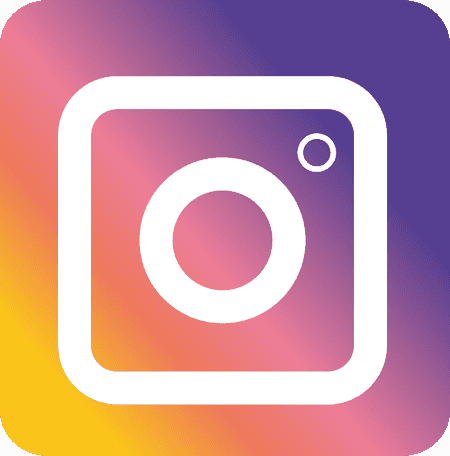
Instagram is an exciting social media platform that can deliver returns through visual techniques
Instagram is becoming increasingly popular among consumers, and with engagement continuing to grow, more and more B2C companies are benefiting from their presence on this social media channel.
From a recent study conducted in 2017, it was found that, out of those surveyed, 64% of B2C marketers found Instagram to be an effective marketing tool for business. On the contrary, only 31% of B2B companies had incorporated Instagram into this marketing strategy, and of this figure, only 15% found it to be effective.
At Opace, not many of our clients use Instagram as a marketing strategy, and so the data we have gathered is not extensive. However, one of our B2C clients found that 66% of traffic to their external website came from Instagram; this figure was 38% higher than the traffic generated by Facebook.
Instagram is a social media channel that has incorporated many different features from other platforms, such as Facebook, Twitter and Snapchat. The incorporation of some of the very best features from these social media channels are reasons why this platform is so popular for business.
The hashtag feature, for example, which is used on both Instagram and Twitter, is a great way for users to follow one another, making content more discoverable and increasing user engagement. A study by Forrester also found that user engagement on Instagram is 120 times greater than user engagement on Twitter, evidencing that the use of a hashtag is actually much more effective on Instagram.
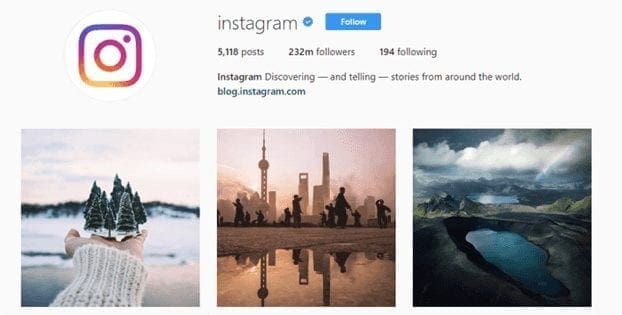
Instagram’s official page on Instagram – does this fuel your imagination?
Instagram stories were added to the social media platform in 2017, a feature which is similar to that which can be found on Snapchat. By posting a short video or picture with a clickable link to an external site, a user can generate traffic in the hope of creating sales leads. A big positive of using Instagram stories for business is the fact that these stories do not get added to a user’s profile, so you don’t have to worry about spamming your followers.
For businesses whose target audience is millennials, Instagram is perhaps the best social media channel to incorporate into a marketing strategy. This is because, in a survey conducted in 2014, approximately 37% of people born between 1980 and the early 1990s were found to be active on this platform.
Therefore, if you are a business wishing to connect with the younger generation, you should definitely be active on Instagram. That being said, the fact that Instagram is so popular among millennials can actually be a downside for businesses marketing on this channel. This is because the competition is now fiercer than ever, with over one million monthly advertisers active on the platform.
Should businesses be using Twitter?
This social networking microblogging and online news site allow users to broadcast short Tweets which are restricted to 280 characters. Users are allowed to follow one another, and in doing so, the followed user’s tweets will show up on the home page of that follower. A user’s personal Tweets are uploaded onto their own Twitter feed in a timeline format. Twitter is arguably the best social media platform for people to view a range of opinions, reviews and news quickly. Thanks to the hashtag and trending features, information virtually anything can be broadcasted worldwide quickly.
Twitter is the only major social media channel which is open; once a user broadcasts a Tweet, it can be seen immediately all over the world. The only exception to this is if a user has made his/her account private. The extremely open nature of Twitter means that marketing on this channel can sometimes be easier than marketing on other social media channels, but it also means that customers are able to voice their complaints about a product or service publicly, which can be bad for business.
Twitter is a great social media platform that allows for businesses to connect and engage with their customers, keeping them up-to-date with any goings-on within the business through short tweets. The fact that tweets are limited to 280 characters, however, means it can be difficult for businesses to advertise a product or service in such a small amount of words.
Despite the potential difficulty of advertising on Twitter, it is still a good social media platform for business; content consumption rose by 25% from 2014 to 2016. Furthermore, statistics show that 60% of a brand’s followers were more likely to buy a product or service after following the brand on Twitter, evidencing that this channel is in fact very good for user engagement and content consumption.

Twitter is no longer a newcomer – it can still deliver great returns in business
The British multinational retailer Marks and Spencer found great success on Twitter through its 2016 Christmas campaign, #LoveMrsClaus. Realising it was losing revenue among those women in the 45-plus age bracket, this campaign focussed on Mrs Claus as a strong female role model, representing the value and personality of women across the UK.
As a result of this campaign, #LoveMrsClaus topped the trending list, and there was an 11-37% increase in recall among women in the 45-plus age bracket, evidencing the success of this Twitter campaign.
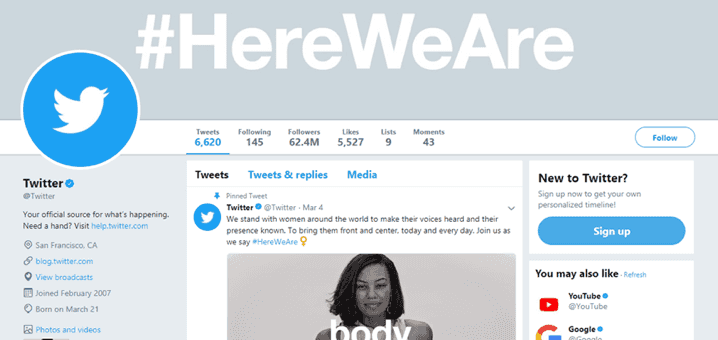
Twitter’s own Twitter page – an example of how a profile can be set-up well
The case study above is that of a B2C company, in fact, our findings at Opace show that Twitter is in fact a good marketing tool for traffic generation for both B2B and B2C companies. Out of the 14 clients we surveyed, Twitter was in the top three social media channels for traffic generation for 12, and in the top five for all those surveyed. These findings imply that Twitter is better for traffic generation than other major social media platforms, such as Facebook, LinkedIn and YouTube.

Twitter is particularly powerful when hashtags are used in integrated marketing campaigns
The potential ROI of Twitter for business is high, thanks to it being an open social media channel with access to over 320 million monthly active users. The ability of followers to retweet your posts, which are then subsequently broadcasted to that user’s followers, is a great way to introduce your brand to more people, increasing brand recognition.
The incorporation of an external link into a user’s tweets can help by introducing customers to your external site, which is another huge ROI of Twitter that businesses on this channel should make use of. Furthermore, it is easy to integrate Twitter with various other social media channels, such as YouTube and Facebook, which can be useful for businesses wishing to diversify their fan base.
It’s certainly exciting times ahead for Twitter with the latest news that Tesla’s Elon Musk is buying Twitter and we can expect the future of Twitter to be an exciting one.
Using YouTube for business
YouTube is a video-sharing site which allows users to watch, upload, rate, share and comment on videos. Founded in 2005, it now receives over 1 billion views per day; if it were a search engine, it would be the #2 largest in the world, bigger than Bing and Yahoo combined.

Youtube enables businesses to harness the power of videos in marketing campaigns
YouTube is a very good social media channel for business, due to the many advantages it can bring to a YouTube marketing campaign. Perhaps the biggest benefit of using YouTube for business is its extremely high volume of traffic, meaning the potential reach of a YouTube campaign is huge.
There are also a vast array of advertising features for businesses active on this social media channel, including display ads, skippable video ads and bumper ads. These advertising options, as well as the targeting options available for businesses, which include demographic groups, interests, topics and keywords, means content can be marketed in various different ways, and to a very specific target audience.
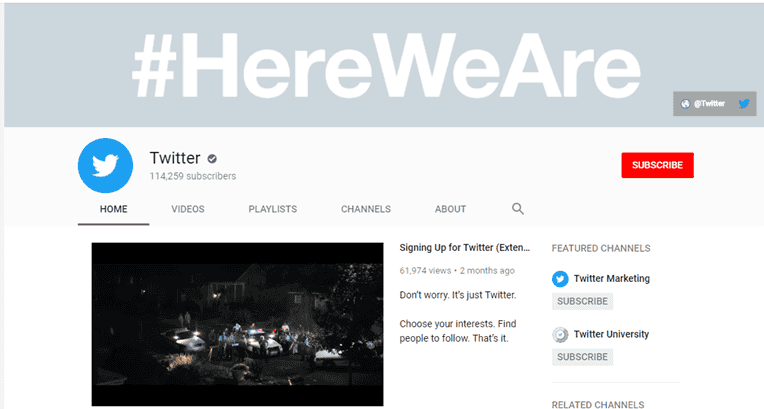
Twitters also recognise the power of marketing through YouTube
An example of a successful marketing campaign that took place on YouTube is Android’s “Friends Furever” video, which featured a compilation of unlikely animal friends. There was nothing particularly relatable to Android’s products service in this video, but it was the most-shared ad of 2015 and goes to show something simple can still be successful in increasing user retention.
However, there are various issues for businesses active on YouTube, including the fact that the related video feature may draw potential customers away from your brand if the videos are about something unrelated to your product or service.
YouTube’s autoplay feature, which works by automatically playing the next related video, can also divert potential customers away from your product or service by automatically playing the next video, which could be unrelated to your product.
Furthermore, the fact that YouTube is an open social media network means that malicious comments posted on any of your videos can be seen by other users. These comments could potentially harm your brand image if seen by potential customers.
Here at Opace, we found that traffic generated from YouTube was rather similar for both our B2B and B2C clients and that these figures were very low when compared to traffic generated from other social media channels.
For our clients that were active on YouTube, traffic generated was between 0.2% and 0.8% of the total traffic generated from various different social media channels. This is a relatively poor figure when compared to previous figures for the other social media channels such as Facebook and Instagram.
However, in a survey conducted in 2016, it was found that 53% of B2C companies and 51% of B2B companies found YouTube to be an effective social media platform in helping them achieve their aims. This implies that YouTube is a good platform for business, and therefore either our clients are not utilising its range of benefits to the full extent, or those businesses surveyed in 2016 were finding it to be successful in ways other than generating traffic to their external websites.
There are many ways for businesses to integrate this social media platform with other channels, something that is crucial for businesses wishing to publicise their brand image. Furthermore, the huge potential to optimise SEO through this channel, as well as its high ROI, do provide a very promising business case.
How beneficial can LinkedIn be for businesses?
A social network catered specifically for the business community, LinkedIn allows users to connect with other business professionals worldwide. Each user has a profile page, where they are able to list their skills, education, employment history, training, and a personal photo.

LinkedIn can very successfully be used as a networking and lead-generation tool
LinkedIn is the largest and most successful professional networking site in the world, currently boasting over 500 million users. This social media channel is catered solely for the business community, and as a result, B2B companies are generally more successful than B2C companies in achieving their aims on LinkedIn.
Data from The Marketing Journal found that 73% of B2B companies surveyed found LinkedIn to be a successful marketing tool for business, while only 32% of B2C companies found it to be effective. This data is rather similar to what we found at Opace; LinkedIn appeared in the top three social media channels for traffic generation for all our B2B clients, together with Twitter.
LinkedIn provides a very promising business case for those businesses looking to expand. It is supposedly the best channel for lead generation, with 2.74% of visitors converting to leads; higher than both Facebook and Twitter.
It also caters for businesses extremely well, and with its wide array of targeting options, businesses are now able to cater adverts to specific demographics. These targeting options include, but are not limited to, location, followers, skills, gender and age.
Furthermore, with the relatively new addition of Matched Audiences to the social media channel, targeting for businesses is now easier than ever. Another benefit of using LinkedIn for business is the fact that, in its simplest form, it is free. Making a complete profile and connecting with other users is free and is therefore good for businesses on a budget.
However, this is only LinkedIn in its simplest and most basic form; users must pay for premium accounts if they wish to benefit from all that LinkedIn can offer. Furthermore, using targeted advertising is rather costly; CPC rates start at around $2, and can be as much as $5, depending on how specific your targeting options are. This sum is greater than other social media channels such as Facebook and YouTube, and can therefore put more of a hole in the pocket of those businesses on a budget.

LinkedIn can generate lots of new business and significant brand recognition
Another downside of using LinkedIn for business is the fact that although there are over 500 million users, only 25% of those visit the site on a monthly basis. This means it can take a while for users to get back to one another, meaning you could be waiting a while for business deals to happen, or to get a reply to a message you may have sent.
Despite these drawbacks, many companies benefit from using LinkedIn, one such company being Microsoft. Microsoft’s LinkedIn page tells compelling stories about how its technology helps many thousands of companies worldwide, increasing user engagement and lead generation.
And despite LinkedIn being catered more for B2B companies, Coca Cola, a B2C company, has found tremendous success on this channel, increasing conversion rates and user engagement through its original content. This shows that B2C companies can find success on LinkedIn if they are also able to also create engaging content catered to their audience.
The ROI of using social media for business can be hard to measure, but LinkedIn does have a high ROI, thanks to the fact that it is a social media channel specifically for professionals. Furthermore, thanks to the many targeting options available for businesses, content can be catered for a specific demographic in a wider population, which can, in turn, help benefit the company through sales, leads and customer acquisition, for example.
Furthermore, the fact that LinkedIn can be integrated with various other social media channels easily, such as Facebook and Twitter, means it is easy for businesses wishing to diversify their fanbase.
Above we have listed a few major social media channels and some of their benefits and drawbacks for businesses. However, all forms of social media offer their own unique advantages for business marketing, and so below are examples of some other social media channels, and what they can offer to businesses.
Simply put, this social media platform is a message board where users post links and text and comment on them. It has been coined “the front page of the internet” and is the sixth most visited site in the world. The stream of content uploaded to Reddit is curated by the community through an upvote and downvote system, determining the link’s or text’s position the channel.
This platform is extremely popular among the younger crowd, and a campaign via Reddit can, therefore, be successful for those businesses whose target market is the 18-29 age bracket. It is a website based around community, meaning engagement on this site can be rather easy between your brand customers active on the site.
It is also a popular site to use for the provision of customer service, as companies can set up sub-Reddits for customers to ask questions or provide complaints, which can then be dealt with appropriately.
As it is a user-driven channel and community, relationships can be managed through the engagement of customers, helping them to deal with any issues with your service or product. Reddit adverts drive more traffic to an external website than Facebook, with many businesses experiencing huge successes using this site. There are options to show adverts to all of Reddit, as well as various targeting options which appear on subreddits.
Pinterest is an online pinboard, whereby users can collect visual bits of information from a vast array of topics and categories. There are approximately 175 million active Pinterest users, 81% of which are females. This social media channel is therefore good for businesses whose target audience is primarily females.
One of the major benefits of Pinterest is users have the ability to group together with their images, which appear on separate boards. This means that people can follow aspects of your business they enjoy while ignoring parts they don’t.
Businesses are therefore able to appeal to the interest of many different users through the creation of separate boards. The share feature makes it easy for users to share your content worldwide, and this, coupled with the fact that all boards are open, means your images can be viewed by anyone in the world, before or after it has been shared. This can help to increase traffic and customer acquisition.
Flickr
Flickr is a photo-sharing platform, where users share and explore each other’s photos. It has around 120 million users around the world, and is set apart from other photo apps due to its focus on the art of photography; it is in essence Instagram for professionals.
Flickr is a social media channel that allows you to expand your online presence, building brand awareness and customer acquisitions through the posting of unique and enticing content. Furthermore, the fact that photos can be easily edited, batched and geotagged means it is easy for a company to tell their story by posting pictures on this site, increasing user engagement. There are also Flickr groups, similar to Pinterest boards, meaning you can post photos in these relevant groups, making your content appealing to a wider range of people.
Google+
Owned and operated by Google, Google+ is a social networking service, similar to other channels on the web. It allows users to connect with one another through the use of various features, such as Google Hangouts, where you can enter a video chat with up to 10 people at any given time. Circles, another feature, are categories for your connections, allowing you to share different updates with different groups of people.
Although Google+ has nearly 400 million active members, there are only 34 million unique monthly visitors. Despite this, there are various benefits for businesses active on Google+, including the fact that Google+ pages have high SEO on Google, as Google’s algorithm ranks these pages highly.
Furthermore, your personal profile and Google+ pages can be connected to your website easily, helping to increase traffic. It is also easy to integrate this platform with other channels, such as YouTube, due to the fact that Google owns this video-sharing site.
WhatsApp and Messenger
WhatsApp and Messenger are instant messaging services, and together, over 1.9 billion people use these apps monthly as a way of staying in touch with others. WhatsApp was acquired by Facebook in 2014, and when you combine Facebook Messenger and WhatsApp, Facebook controls over 79% of the instant messaging market.
Both these messaging services allow for better customer engagement, as they give businesses the ability to respond quickly to any queries from customers. As smartphones are becoming increasingly popular globally, these instant messaging services are a great way to engage with customers.
Instant messaging services are also very good for quick, real-time internal communication within a company; they offer an efficient service which can also be secure, as is seen on WhatsApp with the end-to-end encryption of every message. The fact that short messages can be combined with pictures, videos and voice notes means instant messaging services offer a unique marketing method.
However, those businesses who use instant messaging services as a marketing tool need to ensure they are not spamming potential customers with an array of images and messages.
Social media is a continuously growing industry, and all of the social media channels listed above offer unique ways to market your business. For those businesses wishing to diversify their fan base and widen their audience, having a presence on multiple social media channels is key. However, being active on a social media channel requires time, effort and money, meaning it can be difficult for businesses on a budget to be active on various different channels.
From our findings at Opace, our B2B clients performed better on LinkedIn, while our B2C clients were finding greater success on Instagram and Facebook. Surprisingly, all of our clients found that Twitter was successful in terms of traffic generation, while YouTube was rather unsuccessful, with traffic generated from this channel ranging from 0.2% to 0.8%.
Ultimately, choosing what social media channel(s) to be active on should depend largely on what industry you are in, and what platforms your clientele use. Take time to study business analytics, and this should provide an indication as to what platform is best for you to carry out a concerted campaign on.
Contact Opace today
If you want to find out more about digital marketing, then our team are happy to help today. You can call us on 0121 222 5757 or find our contact details here.
Image Credits: jieun1605, Instagram, joshborup, Twitter, geralt, FreeCliparts, YouTube, illustrate, LinkedIn, joshborup, Facebook, Facebook






0 Comments